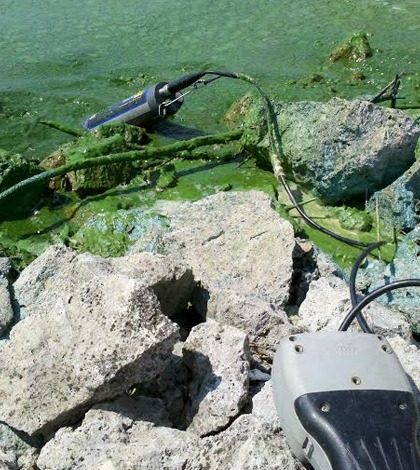National Lakes Assessment: Algae A National Issue

A nearshore Microcystis bloom on Sept. 2, 2011, at Milford Lake in Kansas. (Credit: Eric Looper / U.S. Geological Survey)
When it comes to harmful algal blooms (HABs) in our nation’s lakes, much of the focus gets placed on Lake Erie. And though it’s an important water body for sure, it is not the only freshwater lake in the United States. Results of the National Lakes Assessment (NLA), a first-of-its-kind survey, have just been released detailing that many of the freshwater lakes in the U.S. also have an algae problem.
The assessment, which began data collection in 2007, is part of the U.S. Environmental Protection Agency’s (EPA) National Aquatic Resource Surveys. Those are collaborative programs between the EPA and states and tribes that are designed to assess the quality of waters throughout the United States, be they lakes, rivers, streams, wetlands or coastal regions.
Findings of the NLA cover a huge range of issues and reveal conditions that may help in managing freshwater resources in the future. Its investigators looked at nutrient loads, habitat, contaminants in fish tissues and trophic conditions, among other things. Full results of the effort are detailed in an EPA report.
On the algae front, researchers looked at common cyanotoxins produced by blue-green algae, also known as cyanobacteria, as part of the sampling effort that visited 1,161 lakes across the United States. Each lake was at least 4 hectares in area, or somewhere close to 10 square acres. EPA experts were joined by scientists at the U.S. Geological Survey (USGS) in the effort, employing a number of tools and techniques to get it done.
“The toxin assessment was a small piece of the entire study. Cyanobacteria and their toxins were used as a recreational human health indicator,” said Keith Loftin, research chemist with the USGS’ Kansas Water Science Center. He notes that cyanotoxins have been tied to illnesses and deaths of livestock and companion animals in the U.S.

Harmful algal bloom in Kansas’ Milford Reservoir, June 21, 2016. (Credit: Lindsey King / U.S. Geological Survey)
Lakes were surveyed through ELISA (enzyme-linked immunosorbent assay) analysis of integrated photic zone samples. The ELISA approach is a less expensive screening tool than others while allowing for more simultaneous sample analysis. Multiparameter sondes were also deployed to give researchers snapshots of water quality onsite.
“Secchi depth was used to determine the photic zone for sampling near the center of a lake,” said Loftin. “Samples collected near the center of the lake would be considered to represent more of an ambient sampling versus a worst case type of sample. Blooms tend to concentrate near shore but even at the center of the lakes, we found a 32 percent detection frequency of microcystins which is higher than we expected in the center of the lakes.”
Microcystins are the toxins that made drinking water unsafe for half a million residents of Toledo, Ohio, in 2014. That disaster may have contributed to more focus on the toxin as many studies looked for the presence of microcystin as an indicator that other toxins like cylindrospermopsins and saxitoxins were present.
Loftin and others found detection frequencies of cylindrospermopsins in 4 percent of samples. For saxitoxins, that figure was 7.7 percent. But there really was no relationship between microcystin levels and the presence of either of the other two classes of toxins. Cylindrospermopsins were found alongside microcystins in 0.96 percent of samples and saxitoxins were found alongside microcystins in 5.0 percent of samples. All three classes of toxins were found together in just 0.32 percent of samples.
Because of the time considerations and the fact that scientists visited each lake typically once, it’s not really possible to say that any of the water bodies sampled in the National Lakes Assessment are in great shape or poor shape with respect to future cyanotoxin production, Loftin says.
“We don’t yet know why these toxins are produced,” said Loftin. “The HAB problem has a temporal and spatial nature to it that is very dynamic. Our data look at one point in time, so a label like that can be misleading on a single-lake basis.”
He says he has encouraged folks to take what they’ve learned through investigations in the Great Lakes and apply it elsewhere to better manage freshwater resources across the country.
“The problem is national and we need to do more work to understand HABs and their adverse impacts. Are there steps we can take to keep HABs from getting worse?” said Loftin. “Basically, how can we live in this world and better manage this issue for more effective resource utilization?”
Top image: A nearshore Microcystis bloom on Sept. 2, 2011, at Milford Lake in Kansas. (Credit: Eric Looper / U.S. Geological Survey)




0 comments